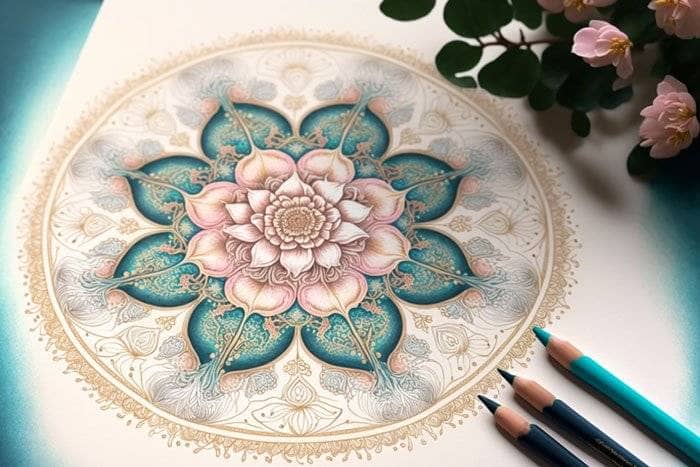Introduction:
In a world brimming with stress and chaos, people seek solace and tranquility in various forms of art. One such art form that has captured the hearts and minds of many is the flower mandala. These intricate circular designs, often adorned with vibrant petals and delicate blooms, serve not only as visually captivating artworks but also as powerful tools for meditation and mindfulness. In this comprehensive guide, we delve into the world of flower mandalas, exploring their origins, significance, creation process, and more.
Understanding Flower Mandalas:
Flower mandalas, derived from the ancient Sanskrit word for “circle,” are symbolic representations of the universe in Hindu and Buddhist traditions. These sacred geometric patterns feature intricate designs that radiate from a central point, often resembling a flower in bloom. The use of flowers within mandalas adds an extra layer of symbolism, representing beauty, impermanence, and the interconnectedness of all living beings.
The Significance of Flower Mandalas:
Flower mandalas hold profound spiritual significance across various cultures and belief systems. They are used as tools for meditation, with practitioners focusing on the intricate patterns to achieve a state of inner peace and harmony. Additionally, these mandalas are often used in religious rituals and ceremonies as offerings to deities or as symbols of auspiciousness and prosperity.
Creating Your Own Flower Mandala:
Crafting a flower mandala can be a deeply fulfilling and meditative experience. Here’s a step-by-step guide to creating your own masterpiece:
Gathering Your Materials:
Start by collecting an assortment of fresh flowers, petals, leaves, and other natural materials. Choose a variety of colors, shapes, and textures to add depth and dimension to your mandala.
Selecting a Sacred Space:
Find a quiet and peaceful environment where you can work undisturbed. Set up a clean surface to serve as your canvas, whether it’s a table, the ground, or a large piece of paper.
Designing Your Mandala:
Begin by arranging the larger elements, such as flowers or leaves, in a circular pattern radiating from the center. Experiment with different layouts and combinations until you find a design that resonates with you.
Adding Details and Finishing Touches:
Once you’re satisfied with the overall layout, fill in any gaps with smaller flowers or decorative elements. Pay attention to symmetry and balance as you add the final touches to your mandala.
Exploring the Symbolism of Flowers:
Each flower carries its own unique symbolism, adding layers of meaning to your mandala. Here are a few examples:
Roses:
Representing love, beauty, and passion, roses are often used as focal points in flower mandalas.
Lotus Flowers:
Symbolizing purity, enlightenment, and spiritual awakening, lotus flowers are a common motif in Buddhist mandalas.
Sunflowers:
With their vibrant yellow petals and uplifting presence, sunflowers symbolize warmth, happiness, and vitality.
FAQs (Frequently Asked Questions):
- What is the origin of flower mandalas? Flower mandalas have their roots in ancient Hindu and Buddhist traditions, where they were use as tools for meditation and spiritual practice.
- How can I use flower mandalas for meditation? To use a flower mandala for meditation, simply gaze at the intricate patterns and allow your mind to focus on the beauty and symmetry of the design. This can help calm the mind and promote a sense of inner peace.
- Are there any specific flowers that are commonly used in mandalas? While any flower can be used to create a mandala, some of the most commonly used flowers include roses, lotus flowers, and sunflowers, each carrying its own symbolic significance.
- Can I create a flower mandala using artificial flowers? While natural flowers are often preferred for their beauty and fragrance, you can certainly create a flower mandala using artificial flowers if that’s what you have available. Just ensure that the colors and textures complement each other well.
- Are there any traditional rituals associated with flower mandalas? In some cultures, flower mandalas are used in religious rituals and ceremonies as offerings to deities or as symbols of auspiciousness and prosperity.
- Can children create flower mandalas? Absolutely! Flower mandalas can be a wonderful creative activity for children of all ages. Allowing them to explore their artistic side while learning about the beauty of nature.
Conclusion:
In conclusion, flower mandalas are not just exquisite works of art; they are also powerful symbols of spirituality, mindfulness, and interconnectedness. Whether you’re crafting your own mandala or simply admiring the beauty of others. Let these intricate designs serve as reminders of the inherent beauty and harmony present in the world around us.


